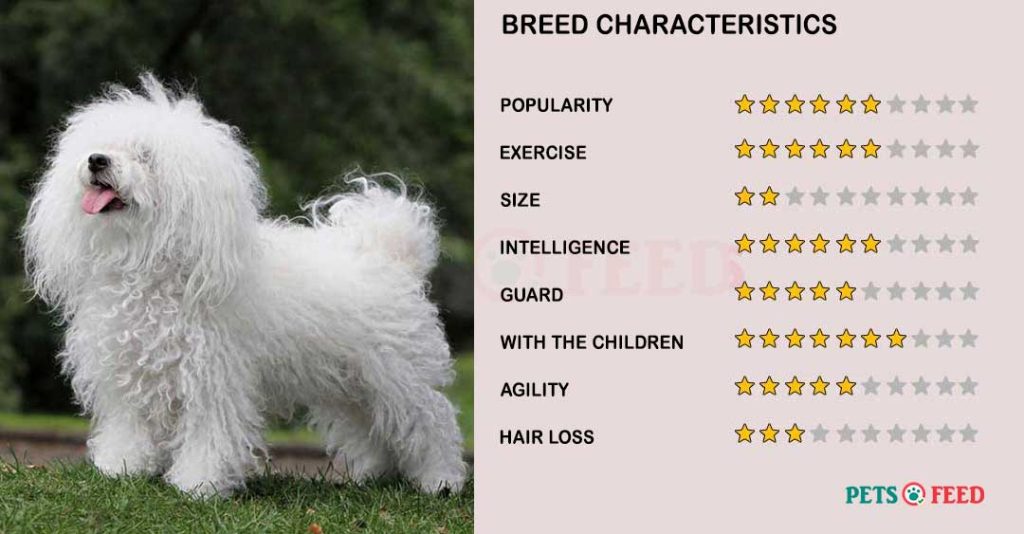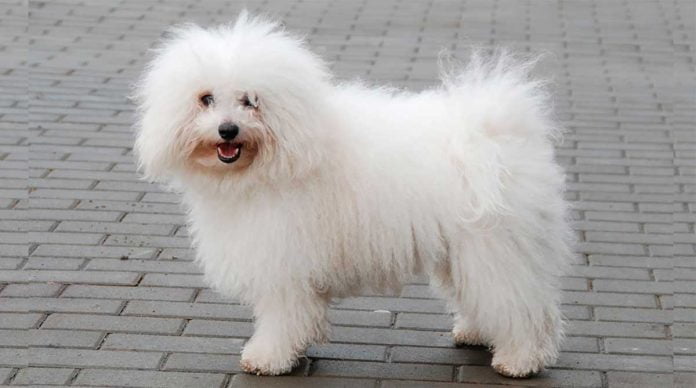Bolognese is style and sheer charm. Snow-white miniature dogs resemble live fluffy toys.
This Italian lap-dog is ideal for apartment living. Such a pet is suitable for adults and children of any age, it turns out to be a cheerful, loyal, friendly companion.
The Bolognese is a small compact dog with white fur and of Italian origin. It is related to the Bichon Frise and the Havanese, and is a rare and difficult to obtain dog.
Representatives of the breed do not cause disappointment, on the contrary, delight the owners, cheer up. With a lap-dog, even the most convinced pessimist will turn into an optimist.

Bolognese photos
[foogallery id=”43765″]
Physical characteristics
At first glance at the Bolognese, it seems that this dog is quite plump. In fact, the representatives of the breed are thin. Volume and airiness are the merit of a lush coat. Although with an elegant physique, the muscles of the Bolognese are developed perfectly.
The growth of an adult Bolognese is 20-30 cm, weight is about 2.5-4 kg.

Distinctive features
- Head: the head is small, round. The landing of the head is proud. The skull is pronounced flat with a clearly convex front part. The front line of the front at the muzzle is clear. The muzzle is short, square.
- Jaws: The teeth are large with a scissor articulated.
- Ears: hanging, long and tied ears high. Near the head.
- Eyes: The eyes are large and round. The color of the iris is black (dark ocher). Eyelids bordered with black. The gaze is expressive and attentive.
- Frame: the body is square. The neck is dry, strong. The back is straight, transforming into a wide and straight rump. The chest is deep and wide with protruding ribs. The belly is slightly returned.
- Members: The legs are short, muscular, parallel. Oval legs. The pads are dark. Black claws.
- Pelage: the coat is lush and silky, completed, forming wicks. The sub-point is surprisingly dense. Shorter on the muzzle than on the rest of the body. The color is white uniform or with yellowish marks on the ears.
Character and behavior
The bolognese establishes a very close bond with its Masters and, in general, does not like to be separated from his close relations. He can be quite reserved with strangers and, although he barks to inform his masters of something unusual or new, he is generally not an aggressive or scandalous dog. He likes to please and learn quickly.
The bolognese is characterized by its docile, calm and loyal character. At home, he tends to be inactive, but outside, he tends to be more energetic. He is very attached to his human family, so he needs constant company, being inappropriate for those who spend long hours away from home.
This breed of dog generally gets along with other dogs and animals, while it can become very shy with strangers. In this sense, and although it is not generally aggressive, it is very important to socialize it from a young age to reduce shyness and even avoid it in adulthood.
On the other hand, the Bolognese is an intelligent and very obedient dog, so that well educated and well socialized is an excellent life partner.
Health
The owner of a Bolognese should know that his pet is predisposed to the following diseases:
- Blockage of the lacrimal ducts (keratitis) – the free drainage of tears is impaired, they flow directly onto the dog’s face. The disease is accompanied by redness and constant tearfulness.
- Allergy – more commonly observed food.
- Inflammation of the cornea of the eye – vision is reduced until it is completely lost.
- Dental diseases – the formation of tartar, gum disease.
- Subluxations – the abnormal location of the damaged organ in relation to the physiological norm. Accompanied by pain and lameness.
- Gastrointestinal diseases – intestinal torsion, diarrhea, bloating.
Life expectancy
The average life expectancy of the Bolognese is about 14-15 years.
Care
The coat of bolognese must be brushed 2 to 3 times a week, although some recommend doing so every day, especially after walks active in the park or in nature.
Also be sure to bathe your pet at least once a month, you should also adjust the hairs.
This breed is generally sometimes cut in the most complex way – it all depends on the owner. Do not forget to monitor the cleanliness of the ears and eyes, as well as to cut the claws.
Exercise time
The bolognese is not particularly active. Walking is compulsory, they should not be long. If the owner does not have time or the occasion, just walk for 20 to 30 minutes with a pocket dog near the house or let her run alone in a private closed courtyard.
Fun facts
- With a certain haircut and combing, the Bolognese looks like a powder puff for powder.
- On many works of art (tapestries, paintings, etc.) dating from the 17-18th century, representatives of the Bolognese breed are depicted.
- Among the owners of Bolognese are such famous personalities as Maria Theresa of Austria, Queen Catherine the Great, Madame de Pompadour, Prince Frederico Gonzago.
- Of all the existing types of lapdogs, the Bolognese is considered the calmest.
- In the 18-19 centuries, the captains of the ships had an interesting habit. On round-the-world travels they took Bolognese with them.
- Often, a lap dog manifests a “small dog” syndrome. The dog begins to feel the main in the family, the mistress of the house.
- The name “Bolognese” is given to the breed in honor of the city of Bologna, it was in this locality of Italy that the species appeared, it was here that its development took place.
- The beginning of the twentieth century brought the Bolognese breed a threat of extinction. Dog handlers of Belgium, Italy, France managed to revive Bolognese. A rebirth from breeding began, in which only nine dogs participated.
History of the breed
Homeland of the Bolognese – Italy. To be precise, the formation of this breed occurred on the territory of Bologna. The emergence of the Italian lapdog dates back to the twelfth century.
At least, it was during this period that the first references to miniature snow-white dogs appeared, very similar to French lapdogs.
In fairness, it is worth noting that there is no exact data on the origin, about the ancestors of the Bolognese. It is known that the breed is ancient, medieval Italy gave it to the world.
There is a version that the direct ancestors of modern Bolognese are the toy poodle and the Maltese.
According to another version, the bolognese came from the Miletus Mediterranean dogs.
In any case, this Italian lap-dog inherited only the best qualities from its ancestors, this breed has practically no drawbacks.
The fifteenth – sixteenth century brought lapdogs a great popularity. Among high society, it was fashionable to have such pets. In those days, there was no special variety of decorative dogs. So, the bolognese soared to the top of fame.
In the eighteenth and nineteenth centuries, many other miniature breeds appeared. As a result, the Italian Bologna, unable to withstand the competition, found itself on the verge of extinction.
The number, as well as the popularity of this species was restored due to the fact that its representatives survived in other countries.
Connoisseurs of the breed were able to achieve official recognition of the Italian lap-dog and registration in international registries as an independent species at the beginning of the 2000s.


